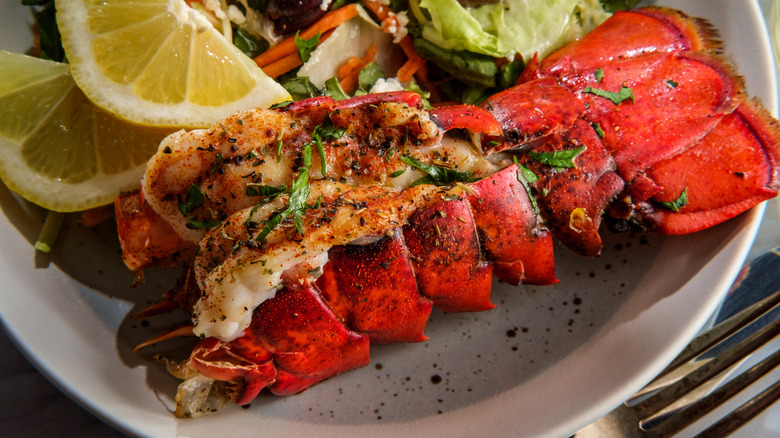What Company Supplies Costco's Lobster Tails?
A Costco membership truly offers something for everyone, making it more than just a place to shop — it's an experience. From dazzling diamond engagement rings to timeless faves like the cheap hot dog and soda food court combo, this retail giant caters both to the everyday shopper and to those seeking something extraordinary. Of course, Costco isn't just about the food court or fancy accessories. Seafood fans know it as a go-to spot for premium fish and shellfish, which raises the question: where does it get its famous lobster tails from?
The answer is Coastal Seafoods. The company supplies Costco with lobsters that are wild-caught in the North Atlantic waters of Maine and Canada. Maine is known for its sustainable lobster and seafood industry, and Costco's lobster is sustainably sourced and humanely trapped. While prioritizing freshness, Costco's lobster is delivered uncooked and frozen, meaning it doesn't contain preservatives, nor is it cooked before reaching the consumer. This approach makes preparing lobster at home simple while preserving a fresh, homemade experience.
It's extremely easy to cook frozen lobster tails, allowing consumers to enjoy a premium seafood experience without compromising quality. From the variety of products to the careful sourcing of items like lobster tails, Costco continues to do what it does best — delivering both convenience and quality.
Costco's commitment to sustainable seafood
In today's climate, sustainably sourced seafood is becoming an increasingly pressing issue, as consumers and companies alike grow more aware of the environmental impact of overfishing and unsustainable practices. By choosing a supplier that sustainably sources and humanely traps its lobster, Costco is already taking important steps toward creating a more eco-friendly and responsible seafood supply-chain model. However, these efforts represent just one part of Costco's broader initiatives aimed at reducing its environmental footprint and promoting sustainability across operations.
According to Costco: "When sourcing seafood, we consider numerous factors to meet our goals of providing high-quality and more sustainable products for our members." And it stands by this. In 2011, after facing public criticism and mounting pressure from Greenpeace, Costco stopped selling certain at-risk seafood in its stores due to overfishing, unless suppliers were certified by the Marine Stewardship Council (MSC). Some of the no-sell fish include Atlantic cod, Chilean sea bass (there's a reason it's so expensive), and bluefin tuna. This move promoted sustainable seafood sourcing and protected vulnerable fish populations, highlighting Costco's commitment to change, even if it meant sacrificing profit and stock.
Costco has also collaborated with organizations such as the Aquaculture Stewardship Council (ASC) with the goal of sourcing responsibly farmed seafood, including shrimp, salmon, and tilapia. Additionally, it supports Fishery Improvement Projects (FIPs), which involve working with local fisheries and governments to meet MSC standards worldwide.


